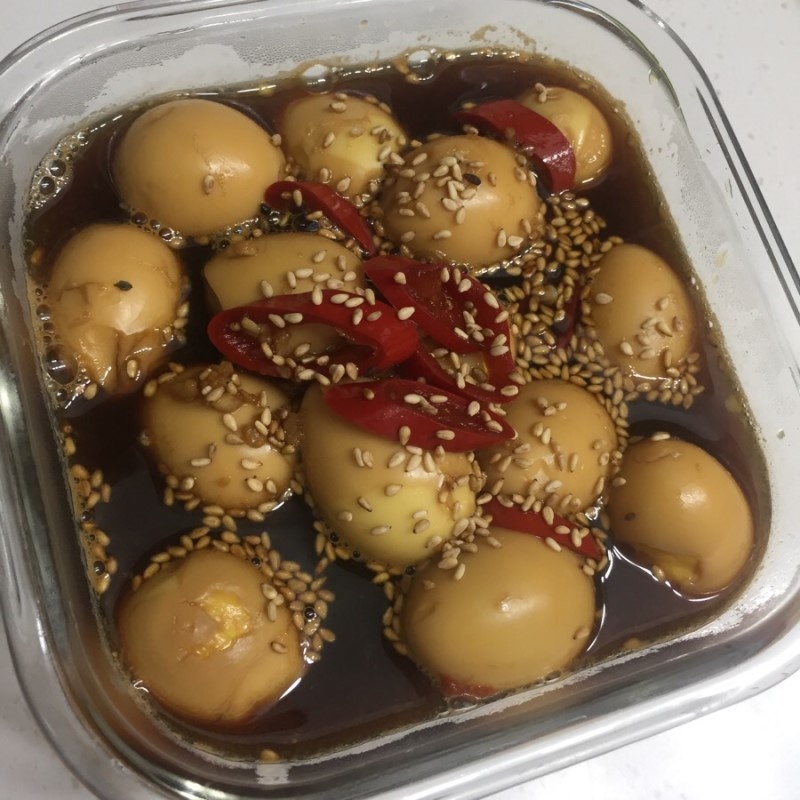Sweet & Savory Quail Egg Jangjorim (Braised Quail Eggs)
Super Simple Side Dish: Perfect Recipe for Quail Egg Jangjorim

Tired of serving only seasoned vegetables as side dishes? We’re making ‘Quail Egg Jangjorim’ today, a special and delicious side dish! If making meat jangjorim feels too much like a hassle, or if you’re looking for a simple yet special side dish other than vegetables, let’s make some sweet and savory Quail Egg Jangjorim to adorn your dining table. ^^ It’s a delightful side that’s perfect as a snack for kids or an accompaniment with drinks for adults!
Quail Egg Jangjorim Ingredients- 28 Quail eggs (1 tray)
- 3 Tbsp Soy sauce
- 1 Tbsp Braising soy sauce (or 4 Tbsp Soy sauce if unavailable)
- 1 clove Garlic
- 1 Red chili pepper
- 2 Tbsp Oligosaccharide (or corn syrup)
- 2 Tbsp Sugar
- 2 Tbsp Toasted sesame seeds
- 1 Tbsp Vinegar
- 1 Tbsp Salt
- 1 sheet Dried kelp (Kombu)
- 250ml Water (approx. 1 cup)
- 1 Tbsp Cheongju (rice wine)
Cooking Instructions
Step 1
Place the quail eggs in a pot and cover them with water. Add 1 Tbsp of vinegar and 1 Tbsp of salt to the water; this helps prevent the eggs from cracking while boiling and makes them easier to peel later. Start by simmering over low heat, gently stirring with a spoon. Once the water begins to boil, increase to medium heat and continue stirring for about 10 minutes. This ensures the quail eggs cook evenly and are easy to peel.

Step 2
After boiling, rinse the quail eggs under cold water and then soak them in cold water for a while. This step makes peeling the shells much easier. Once cooled, peel the eggs and set them aside.

Step 3
Now, let’s prepare for the braising process. In a pot, add 250ml of water (a little over 1 cup). Don’t worry if the amount of water seems a bit much, as some will evaporate while braising, concentrating the flavors. This amount is a good starting point for a delicious jangjorim.

Step 4
Add 1 sheet of dried kelp (kombu) to the water and bring it to a boil. The kelp will add a wonderful depth of umami flavor to the braising liquid.

Step 5
Pour in 3 Tbsp of soy sauce. This forms the base of our savory and salty sauce.

Step 6
Add 1 Tbsp of braising soy sauce. If you don’t have braising soy sauce, you can substitute it with an additional 1 Tbsp of regular soy sauce (making it 4 Tbsp total). Braising soy sauce adds a richer color and flavor.

Step 7
Add 2 Tbsp of sugar to introduce sweetness, balancing the saltiness and making it appealing even to children.

Step 8
Add 1 Tbsp of minced garlic. If you don’t have minced garlic, you can finely slice 1 clove of garlic instead. Minced garlic will infuse its robust flavor more intensely into the sauce.

Step 9
Stir in 1 Tbsp of Cheongju (Korean rice wine). This helps to eliminate any potential ‘gamey’ or unpleasant odors from the eggs. After adding the Cheongju, remove and discard the kelp sheet, as leaving it in too long can impart a slightly bitter taste.

Step 10
Add all the peeled quail eggs to the pot with the simmering braising liquid. Gently stir to ensure the eggs are coated with the sauce.

Step 11
Prepare one red chili pepper. This will add a lovely color and a subtle hint of spice.

Step 12
Slice the red chili pepper diagonally and add it to the pot. The vibrant red will enhance the visual appeal, and the mild chili aroma will add another layer to the flavor profile.

Step 13
Add 2 Tbsp of oligosaccharide (or corn syrup). This adds a beautiful sheen and a smoother, less harsh sweetness than plain sugar.

Step 14
As the jangjorim simmers, skim off any foam that rises to the surface. This will result in a clearer and more refined sauce. Continue to simmer vigorously, stirring occasionally, until the sauce thickens to your desired consistency. Your delicious Quail Egg Jangjorim is now ready to be enjoyed!



